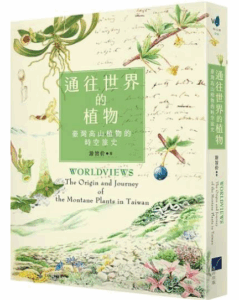
Chih-Chieh, Yu
Taipei: SpringHill Publishing, 2020.
Reviewed by: Ryan Xin Xie (PhD Candidate, Chinese University of Hong Kong, HYI Visiting Fellow)
“Where did the plants on Taiwan’s high mountain come from?” This modest question launches Worldviews: The Origin and Journey of the Montane Plants in Taiwan into a rich exploration of biogeography, natural history, and the deep entanglements between plants, landscapes, and people. Written by a scholar of mountain plant biodiversity, the book blends scientific insight with narrative clarity, drawing on years of fieldwork to trace how Taiwan’s montane and alpine flora reflect both evolutionary journeys and the island’s place in a dynamic, interconnected world.
The book unfolds across eight richly layered thematic chapters, beginning with the story of the “giant trees” — the iconic Taiwan red cypress (Chamaecyparis formosensis), whose disjunct distribution links East Asia to North America. From there, it follows the northward migration of Chaerophyllum, a Southern Hemisphere genus of flowering plant, and explores rapid speciation in genera like Berberis. Later chapters survey respectively endemic genera, Taiwan’s conifers richness, and Japanese-affiliated flora in local forests.The book also highlights the ecological role of limestone geology which shapes specialized plant communities, and concludes with high-elevation alpine species—glacial flowering plants which are blooming above the tree line. These plants serve as markers of Ice Age history and as evidence of the island’s role as a biodiversity refuge.
Through careful integration of phylogenetics, paleontology, and natural history, Worldviews situates Taiwan’s montane plants within the broader biogeographical richness of East Asia—one of the most ecologically diverse and resilient regions on Earth. Unlike much of Europe and North America, East Asia escaped the full brunt of glaciation during the last ice age, allowing ancient plant lineages such as Ginkgo and Cathaya to survive and diversify. Its uninterrupted landscapes, ranging from Arctic tundra to tropical rainforest, have long served as evolutionary refuges, where stable climates fostered both species persistence and diversification. It is within this dynamic setting that Taiwan emerges as a microcosm of East Asia’s ecological richness. The island’s high mountains, formed through ongoing orogeny, became landing sites for alpine species shaped by ice age migrations and elevational shifts. These plants, some with roots in the Himalayas and others from distant temperate zones, carry stories of intercontinental connectivity and adaptation.
One of the book’s key strengths lies in its careful attention to cultural and linguistic specificity. Through examples like Berberis—reviled by some hikers in Taiwan as an invasive nuisance, yet revered elsewhere as a symbol of love, a source of traditional medicine, or a prized culinary ingredient. The author demonstrates how plants carry vastly different meanings across geographic and cultural contexts. These associations remind us that plants are never just biological entities—they are social actors, entangled in memory, identity, and aesthetic value.This sensitivity extends to the book’s use of language. The author makes a deliberate distinction between “alpine” and “montane” plants, justifying the translation of montane as “高山植物” (high mountain plants) rather than “山地植物” (upland plants). Such terminological care reflects a wider perspective of thinking with plants not only ecologically, but culturally and relationally—attuned to place, perception, and the stories plants carry with them.
Worldview is both precise and poetic. It offers new ways of seeing land through plants as storytellers, as place makers, and as co-authors of Taiwan’s natural history. In a region where questions of identity and belonging are complex, plants offer a quiet yet powerful expression of connection to place—rooted in ecology, shaped by history, and resonant with meaning. The same poetics quality carries through to the book’s visual dimension.The book is beautifully complemented by detailed scientific illustrations from Huang Han-Yau and Ong Jin-Yao, whose artwork brings the plants to life with precision and care. Their drawings not only enhance the scientific clarity of the text but also add an aesthetic depth that invites close and attentive observation.
The author’s inquiry continues in his second book, Traverse Taiwan: On the Phytogeographical Origin of Montane Plants in Taiwan (2023), where he extends his biogeographical exploration beyond Taiwan to the Hengduan Mountains and the broader Pan-Tibetan Highlands. Building on the foundation laid in Worldviews, this volume traces the geographic and evolutionary relationships between montane plant species of Taiwan and those of interior East Asia, particularly Yunnan. Drawing on fieldwork, fossil evidence, and molecular research, it enriches the regional perspective and brings the reader deeper into the historical terrain from which Taiwan’s montane flora emerged.
For readers in ecology, geography, environmental humanities, as well as naturalists and curious general readers, these books offer a grounded and compelling perspective on Taiwan’s ecological and biogeographical significance. It is a richly textured account of plant life as a lens through which to understand place, history, and connection across scales.
A note of appreciation: Dr. Chih-Chieh Yu kindly reviewed an earlier draft of this review and offered valuable clarifications to ensure scientific accuracy and contextual nuance.
Reference:
Chih-Chieh, Yu. 2023. Traverse Taiwan: On the Phytogeographical Origin of Montane Plants in Taiwan. Taipei: SpringHill Publishing.
